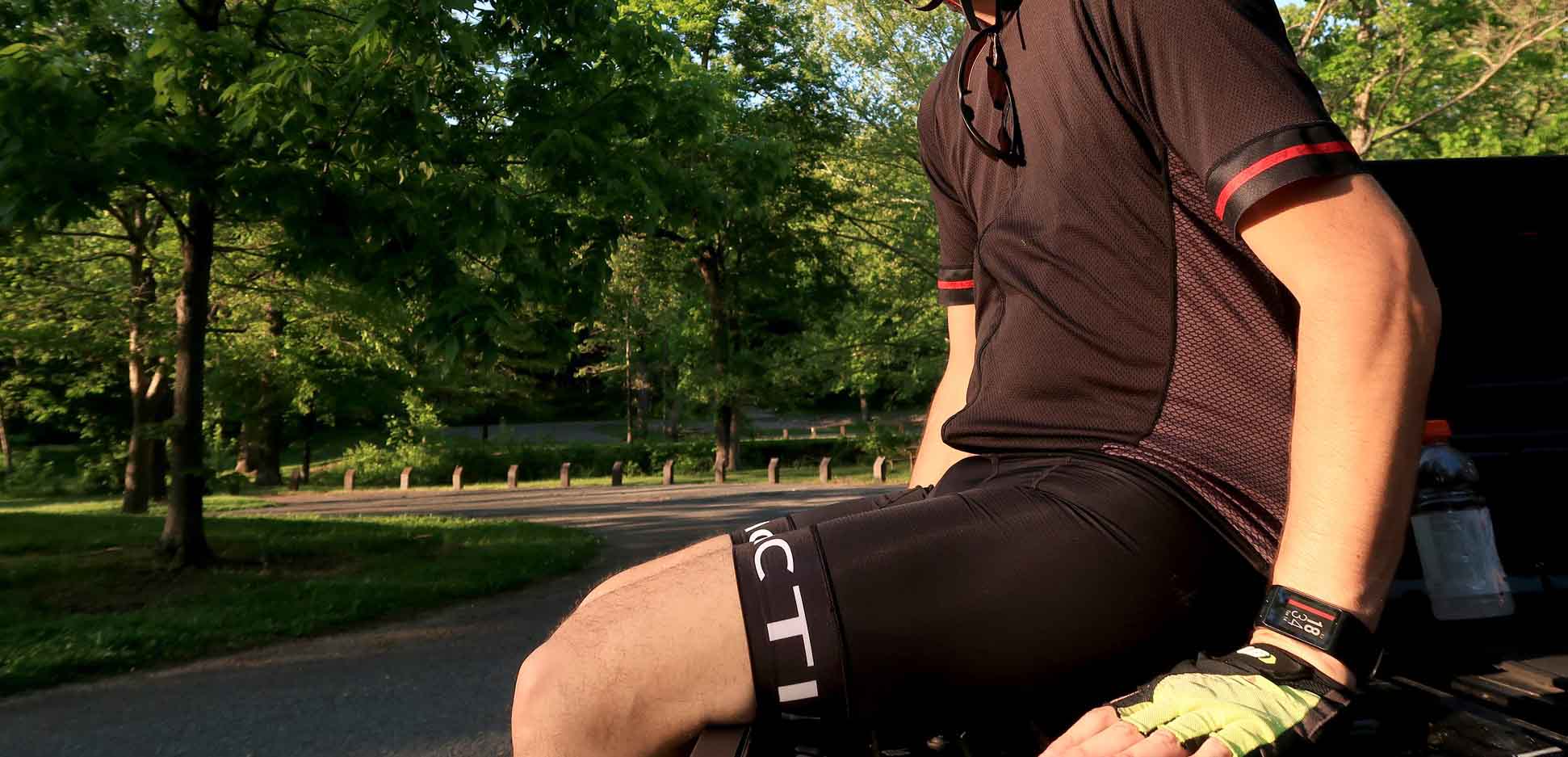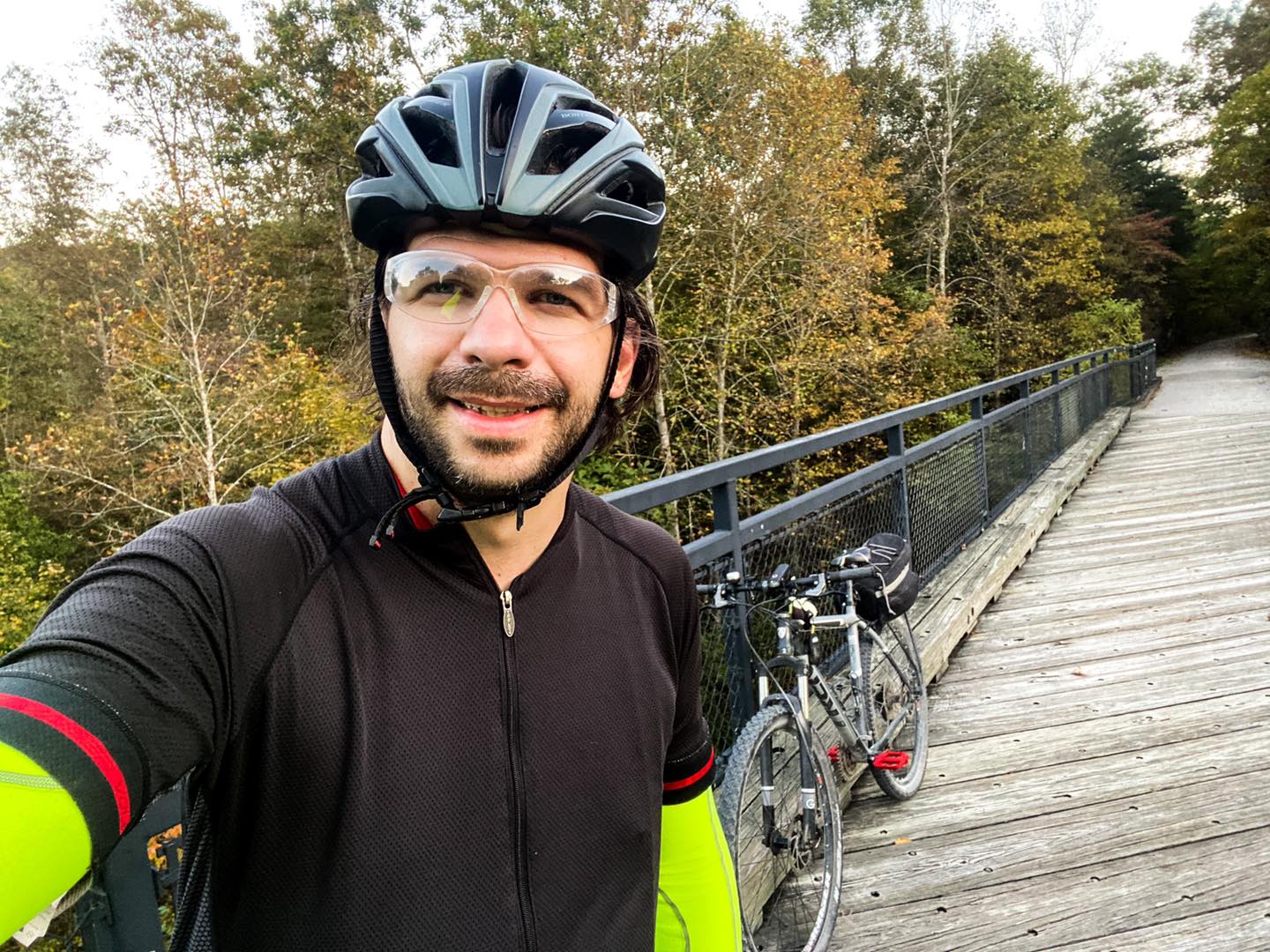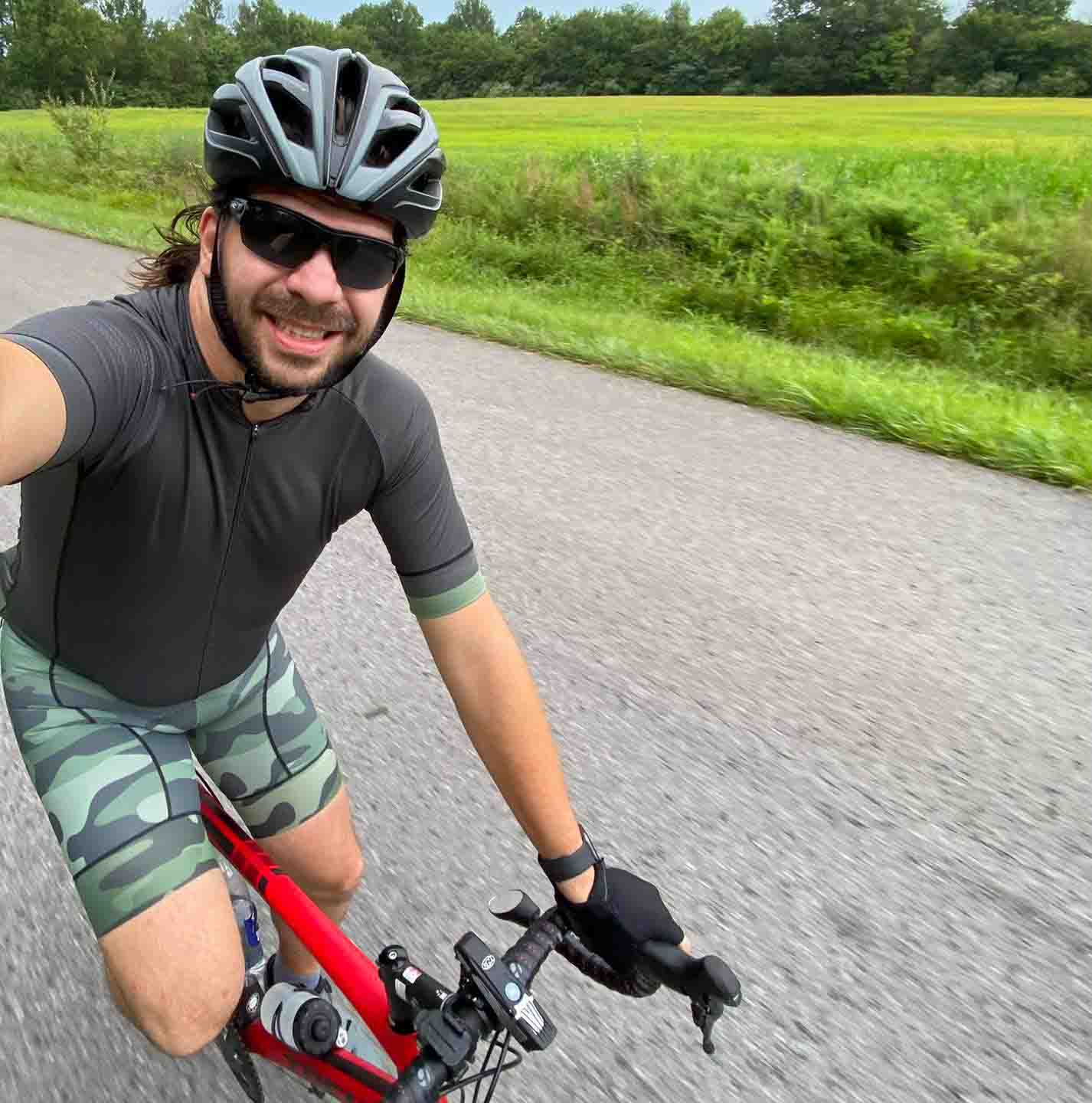15 Cycling Gear Basics for Beginner Cyclists
Having the right cycling gear basics is important for beginner cyclists.
In order to ride efficiently and safely, you want to make sure you wear the right apparel and use the right cycling gear. If you get into a situation where gear is required that you don’t have, it can definitely cause your ride to be a negative experience.
By understanding the cycling gear basics, you can ensure a positive experience on every bike ride.
In this guide, I’ll show you 15 basics of cycling gear that every beginner cyclist should live by.
Why are Cycling Gear Basics So Important?
Having the right cycling gear basics is important for a number of reasons.
The right cycling apparel will help keep you pain-free and comfortable during your ride. Cycling apparel is designed specifically for cycling and the problems that often accompany cyclists who are on their bikes for a longer period.
The right cycling basics will also help keep you safe while you ride.
The good news is that it doesn’t require you to carry a lot of gear, but you should at least carry the basics, which we will go over in this guide.
Tips for Cycling Gear Basics
Consider adopting the following cycling gear basics for your next cycling adventure.
1 – Wear Padded Shorts
Of all the cycling gear basics I can give you, I highly recommend you wear padded bike shorts.
Many beginner cyclists feel awkward and have low confidence about wearing skintight Lycra cycling shorts in public. The truth is that no one really cares about it. Cyclists are known to wear it. The person driving in a car might make fun of you, but your fellow cyclists aren’t because they know the benefits of padded shorts.
The main benefit is the padding or the chamois. It prevents chaffing and absorbs shock. It can keep your very sensitive areas from being in pain after riding your bike for a while. It’s for function, not fashion.
Cycling shorts are made to be worn as a first layer so no underwear with them.
You can get padded liners or even baggy-styled cycling shorts, but the tighter-fitting Lycra styles do better than those that are not tight. The compression helps with muscle recovery. The material wicks sweat and moisture from your body. The second skin makes you more aerodynamic.
It’s all about function, not fashion.
I recommend cycling bib shorts. That’s what I wear. I like ones with cargo pockets on the side. My favorite brands include The Black Bibs, NeoPro, and Aero Tech Designs.
Check out WILDCYCLER, too. They have nice full cycling kits with colorful designs, which are great for road biking since drivers will likely see you quicker.
You won’t be upset after you wear padded shorts on your bike rides.
2 – Get More Cycling Apparel
Cycling bibs don’t cover all the cycling gear basics of apparel.
You should get a few other items, too.
Get a full cycling kit. A pair of bib shorts or cycling shorts should be completed with a cycling jersey, cycling socks, cycling gloves, and a cycling hat.
For cooler weather, get a base layer shirt, long-sleeve jersey, arm warmers, and leg warmers.
For cold weather, you might need some bib tights, thermal cycling gear, a jacket, and shoe covers.
Cycling is worth spending money on to get as much apparel as you’ll ever need.
3 – Get Clipless Pedal and Shoes
Get a decent pair of cycling pedals and shoes.
These pedals and shoes let you clip into the bike.
Don’t be intimidated by them. They may feel weird at first. Ride around the blog or on a trail away from others as you get used to them.
They’re extremely beneficial! They keep you on your pedals. That allows you to improve your cadence and overall cycling technique.
You can get road shoes and pedals for a road bike; otherwise, I’d recommend mountain biking shoes and pedals for gravel bikes, hybrids, and, of course, mountain bikes.
If you feel a foot or knee pain after using the cleats, you may need to adjust them. Find your comfortable pedal position and go with it.
You’ll learn to quickly fall in love with cycling gear basics like pedals and bike shoes.
4 – Layer Your Cycling Apparel
I’m a big advocate of layering cycling apparel for colder rides.
One of my favorite pairs of bib shorts is my thermal bib shorts by The Black Bibs. That’s because I can wear them on cooler bike days with leg warmers. If I get too warm, I can take the warmers off, and the thermal bib shorts balance it all out.
Layering helps you balance your temperature and mitigate sweating, which can lead to problems when it’s really cold.
This is how I layer up on cooler days that will warm up as I ride:
I wear my thermal bib shorts with leg warmers. I wear a base layer t-shirt under my short-sleeved jersey. I wear warm warmers with the jersey. I wear a windbreaker jacket. The jacket and the warmers can be removed as needed and are easy to wrap up and keep in my jersey pockets while I ride.
Layering up is the way to go.
5 – Wear a Bike Helmet
You should consider wearing a bike helmet.
I can’t be the type to tell you that you have to wear a bike helmet. It’s really up to you. Some people live by them, but others do not like to wear helmets.
The benefits of wearing a bike helmet outweigh the benefits of not wearing one.
A helmet can protect your head and brain from impact during a bike wreck. It can also save your life and prevent you from being bedridden for the rest of your life. A certified bike helmet is one of the smartest cycling gear basics that you’ll ever own.
It’s worth noting that many organized bike rides, events, races, and even some local communities require you to wear a helmet if you wish to ride.
In some areas, you can be fined for not wearing a helmet.
If you ever wreck, be sure to replace your helmet, as it will be ineffective after an impact.
Mess your hair up and wear a helmet so you can live to talk about your next bike ride.
6 – Wear More Protection When Mountain Biking
If you’re into mountain biking, you might consider wearing more protection.
A simple bike helmet might not be enough.
You might consider knee pads, elbow pads, and a neck guard. A full-face mountain bike helmet is another good piece of gear for this style of cycling.
These extra pieces of protective gear will help you prevent injury in the event of a wreck. The possibility of wrecking your bike definitely increases when you’re doing some mountain biking. This is especially true for technical riding and downhill.
You might even get padded shorts with extra padding on the sides, chest padding, and other items like that. This would be warranted for competition downhill mountain biking.
Mountain bike wrecks are typically harder and with more impact, so it’s important to take precautions and use the right gear.
7 – Wear Safety or Sunglasses
Eye protection is so important for a cyclist.
Many eye intrusions can occur when you’re cycling outdoors.
The sun can impair your eyes, rain can get in them, bugs can fly into them, and debris kicked up from your tires can get into them. These eye intrusions can cause pain and blindness and even require you to stop riding.
I made the mistake of forgetting safety glasses on a century ride. A few miles in, something got in my eye and got worse for the entire ride. I finished the ride but had problems for about a week after that. I almost had to go to the hospital.
We need our eyes as cyclists, and for everything else we do. It’s important to protect them.
Wear a pair of sunglasses or at least safety glasses when you’re out biking.
8 – Use Fenders in Wetter Conditions
Fender usage during wet riding conditions can go a long way.
As you ride in wet conditions, you throw up debris from the surface you are riding on. Some surfaces are worse than others. A road may not have that much debris, but you’re still likely throwing up rainwater as you ride. A dirt or gravel road is going to be a lot worse.
This can cause debris to get on you, in your eyes, and in your hair. You’ll likely be filthy before you know it.
It also can make your bike dirty and require you to clean it more often.
Fenders are a great way to mitigate these mishaps.
They don’t always look the best on bikes, but they can keep you from getting grime all over you and your bike. That goes a long way at the end of the day when you’re not in the mood to clean your bike.
Try fenders and see how you like them if you’re having issues with dirt and grime.
9 – Use a Bike Computer
A good piece of beginner cycling gear is a bike computer.
Bike computers are good for monitoring cycling progress. Most basic computers allow you to view your speed, mileage, and averages. Add-on components can also measure heart rate and other bodily functions, which can help you better understand performance.
Bike computers come in all types and sizes. You can get a basic computer for under $100, or you can spend a few hundred or more to get a more advanced one. You could even use a fitness watch or an Apple watch to act as your bike computer.
Most bike computers can be integrated with cycling applications, such as Strava, Garmin, and Wahoo.
Get the bike computer that fits your goals and monitor your performance so that you know what you need to work on.
10 – Always Use Lights Day and Night
A great beginner cycling gear tip is to get bike lights and use them day and night.
This is especially the case for road cyclists or those who will be cycling on roads also used by motorists.
You want to make sure that drivers see you coming because it’s so easy for them not to see you until it’s too late. Well, too late for you, at least. So, what do you do?
Lights!
Buy bright and weatherproof bike lights. Turn them on no matter what time you go for a ride. That’s one extra way a motorist will spot you quicker.
11 – Carry Cash
You should always carry some cash with you when biking.
This is especially true for folks who bike in rural parts of the country.
Not every store is setup to take a credit or debit card. Carry cash with you just in case you run into that.
You don’t have to carry a large amount with you, but you should at least have some cash.
12 – Upgrade Your Saddle
A good beginner cycling gear tip is to upgrade your saddle.
Sometimes your butt hurts biking. That can be fixed by wearing padded cycling shorts. But sometimes it keeps hurting after that. It might be all in your seat.
A saddle is what we call the bike seat.
The factory saddle isn’t always the best, especially on cheaper-end bicycles. It’s best to ride and try to get used to your saddle, but in some cases, you might need to upgrade it.
There are different saddles for different kinds of cycling.
Ask around, do your research, and try out a new saddle if you need to.
13 – Use a Bike Lock
Get a bike lock and lock your bike up.
The last thing you want to see is your bike…. GONE.
There are bike thieves out there. Bikes are easy to steal and an easy way to make a couple hundred dollars. Chances are that law enforcement will likely not find your bike, especially if they have more pressing matters to attend to.
The best way to avoid all that is to get a good bike lock.
Lock your bike up if outside and you’re not using it. Otherwise, keep your bike inside in a secure place. Sometimes, it’s a good idea to lock your bike up inside, too.
Make it hard for people to steal your bike.
14 – Set the Seat Height Correctly
Many cyclists fail to set the height of the seat the right way.
If you can, you should get a bike fit before you take your bike out of the shop you bought it from. You can get a bike fit on a bike you didn’t buy from a shop, too. They usually don’t charge too much to give you a basic fit.
An improper seat and saddle height will likely cause pain. You may feel the pain in your back, knees, or feet. Once the seat is at the right height, the pain should go away completely.
When in a seated position, your foot should not be able to touch the ground flat. You should be on your tiptoes, barely able to touch the ground.
Make sure your saddle height is adjusted for your bike fit.
15 – Don’t Stress About Cycling Gear
Beginner cycling gear is best to acquire as needed, not all at once.
Don’t stress about not having the right gear when you’re just getting into cycling.
You can buy more gear when you discover a need for that gear.
And don’t think you need to get name-brand, super-expensive gear every time. There is no need to go broke as a cyclist. Spend the money on what you think is worth it.
But do note that you’ll get what you pay for in most cases.
Final Thoughts About Cycling Gear Basics
Beginner cycling gear is an important topic for beginner cyclists to consider. Following the tips above will get you started with a great collection of cycling gear. You’ll learn more as you keep riding and keep reading more of these articles.
Thanks for reading, and be sure to share this article with other cyclists.
If you’d like to support me in writing and publishing this article for free, send me a one-time donation. You should also subscribe to my free newsletter for upcoming weekly cycling tips and resources.
About Shawn Gossman
Shawn Gossman is the author of this post and founder of the Beginner Cycling Tips Blog.
Shawn has been an avid cyclist for around 12 years. He road, gravel, mountain, and trail bikes. He likes adventuring more than racing.




